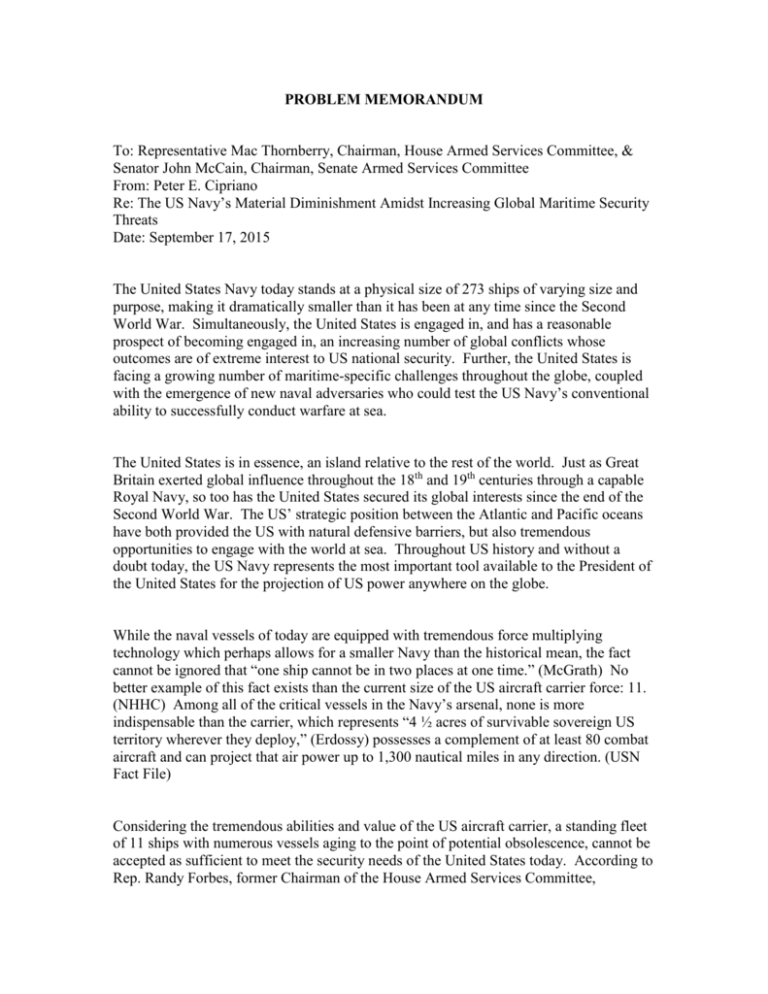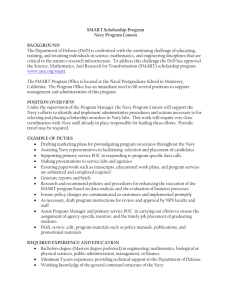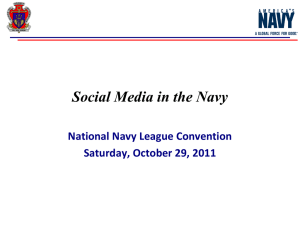Decline of US Navy_Problem Memo
advertisement

PROBLEM MEMORANDUM To: Representative Mac Thornberry, Chairman, House Armed Services Committee, & Senator John McCain, Chairman, Senate Armed Services Committee From: Peter E. Cipriano Re: The US Navy’s Material Diminishment Amidst Increasing Global Maritime Security Threats Date: September 17, 2015 The United States Navy today stands at a physical size of 273 ships of varying size and purpose, making it dramatically smaller than it has been at any time since the Second World War. Simultaneously, the United States is engaged in, and has a reasonable prospect of becoming engaged in, an increasing number of global conflicts whose outcomes are of extreme interest to US national security. Further, the United States is facing a growing number of maritime-specific challenges throughout the globe, coupled with the emergence of new naval adversaries who could test the US Navy’s conventional ability to successfully conduct warfare at sea. The United States is in essence, an island relative to the rest of the world. Just as Great Britain exerted global influence throughout the 18th and 19th centuries through a capable Royal Navy, so too has the United States secured its global interests since the end of the Second World War. The US’ strategic position between the Atlantic and Pacific oceans have both provided the US with natural defensive barriers, but also tremendous opportunities to engage with the world at sea. Throughout US history and without a doubt today, the US Navy represents the most important tool available to the President of the United States for the projection of US power anywhere on the globe. While the naval vessels of today are equipped with tremendous force multiplying technology which perhaps allows for a smaller Navy than the historical mean, the fact cannot be ignored that “one ship cannot be in two places at one time.” (McGrath) No better example of this fact exists than the current size of the US aircraft carrier force: 11. (NHHC) Among all of the critical vessels in the Navy’s arsenal, none is more indispensable than the carrier, which represents “4 ½ acres of survivable sovereign US territory wherever they deploy,” (Erdossy) possesses a complement of at least 80 combat aircraft and can project that air power up to 1,300 nautical miles in any direction. (USN Fact File) Considering the tremendous abilities and value of the US aircraft carrier, a standing fleet of 11 ships with numerous vessels aging to the point of potential obsolescence, cannot be accepted as sufficient to meet the security needs of the United States today. According to Rep. Randy Forbes, former Chairman of the House Armed Services Committee, Subcommittee on Seapower and Projection Forces, “in 2007 [the Navy] met 90% of the combatant commander’s requirements. Today [2014] we will only meet 43%.” (Osborn) This represents a stunning and disconcerting decline in the ability of our fleet to conduct operations overseas as needed by the global military commands. Beyond the core role of the aircraft carrier itself, the Navy is also in need of more surface vessels which comprise the vital carrier strike group. The group provides numerous auxiliary security and supply roles in support of the aircraft carrier’s mission while deployed. The fleet’s shrinking size means not only greater downward pressure on the size of the carrier fleet itself, but the viability of adjoining carrier strike groups and their effectiveness. Presently the United States has security challenges in Syria, Iraq, Afghanistan, the Horn of Africa, North Africa, the Korean peninsula, the Arctic Circle, and the South China Sea. All of these hotspots with the exception of Afghanistan, are navy-accessible, and in some cases, primarily maritime challenges altogether. This is most vitally the case in the South China Sea and the Arctic Circle. In these theaters, the United States is being challenged by the newly assertive People’s Liberation Army Navy (PLA Navy) and the Russian Navy respectively. Not since the collapse of the Soviet Union and the end of the Cold War has the US Navy faced a serious challenge from an adversary fleet. This new reality will require the Navy to become more flexible in its operational capacity, as it is called upon to complete missions as divergent as sea-to-surface or air-to-surface strikes for the degradation of terrorist forces, to potential sea-to-sea operations against opposing naval forces. These increased pressures will require a larger fleet with more ship roles, not fewer ships with fewer abilities. One need look no further than the PLA Navy’s development of an anti-carrier land-based missile, and its coordinated development of an anti-access/areadenial regional maritime strategy designed to lock the US Navy outside of the South China Sea, and potentially pushed beyond operational ability in Taiwan and the Philippines. (Clover) In conclusion, any Defense Budget under consideration before the Congress must consider the invaluable resource that is the US Navy. The present rate of shrinkage from 318 ships in 2000, to 273 ships today represents a decline of 14% in overall fleet size, with an 8% decline (NHHC) in the carrier fleet alone projected to reach 16% in the near future if proper budgetary action is not taken. (Erdossy) Works Cited McGrath, Bryan. "A Bigger Navy and the Spirit of 2007." Hudson.org. Hudson Institute, Center for American Seapower, 1 Sept. 2015. Web. 15 Sept. 2015. “NHHC” – Naval History and Heritage Command, US Ship Force Levels 1886-Present <http://www.history.navy.mil/research/histories/ship-histories/us-ship-forcelevels.html#1945> Erdossy, Marty. "Why Does the United States Only Have Eleven Aircraft Carriers?" Forbes.com. Forbes, 12 July 2012. Web. 15 Sept. 2015. “USN Fact File” - "Navy.mil Home Page." The US Navy. Department of the Navy, n.d. Web. 15 Sept. 2015. Clover, Charles. "China Parades ‘carrier-killer’ Missile through Beijing - FT.com." Financial Times. 3 Sept. 2015. Web. 15 Sept. 2015.







